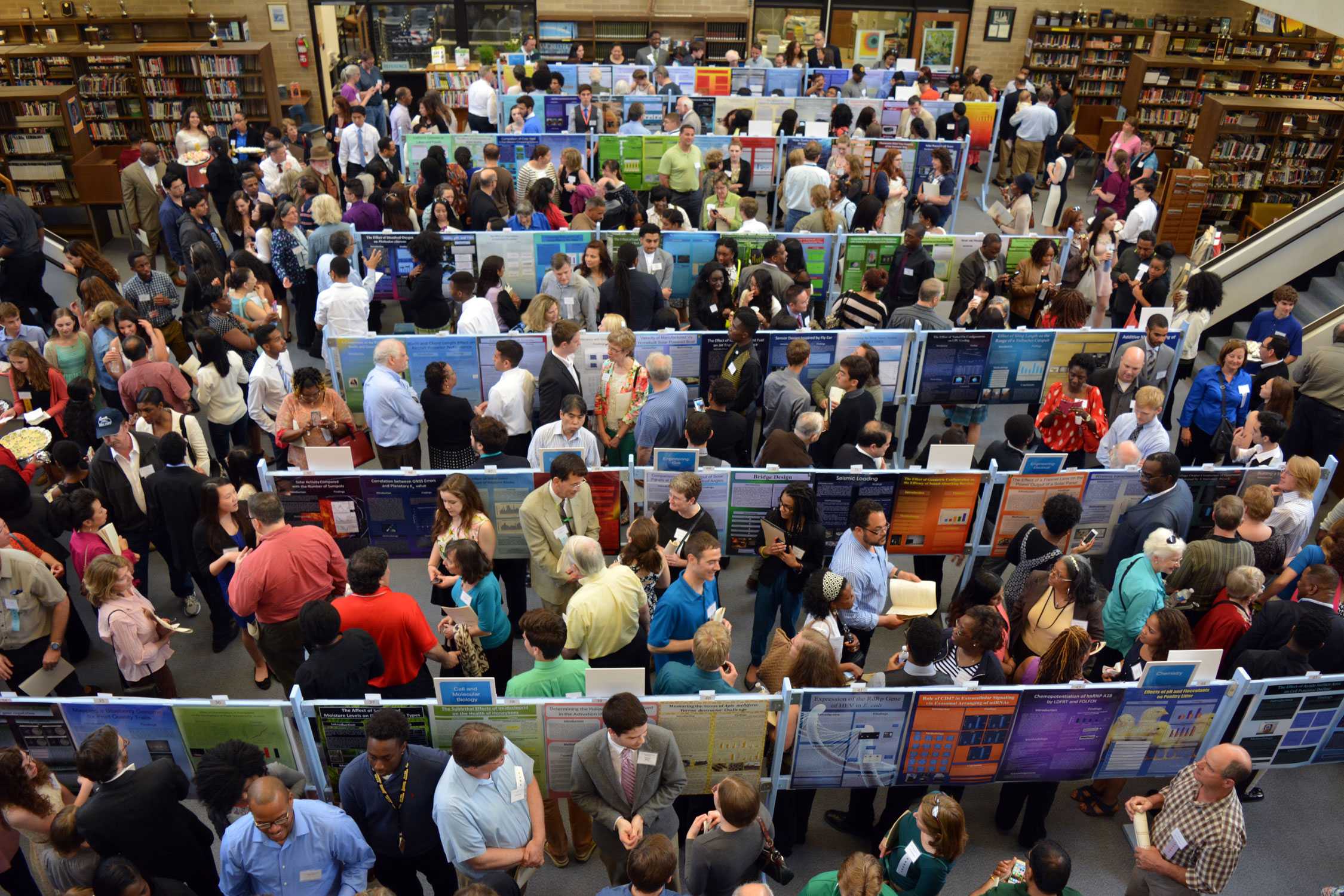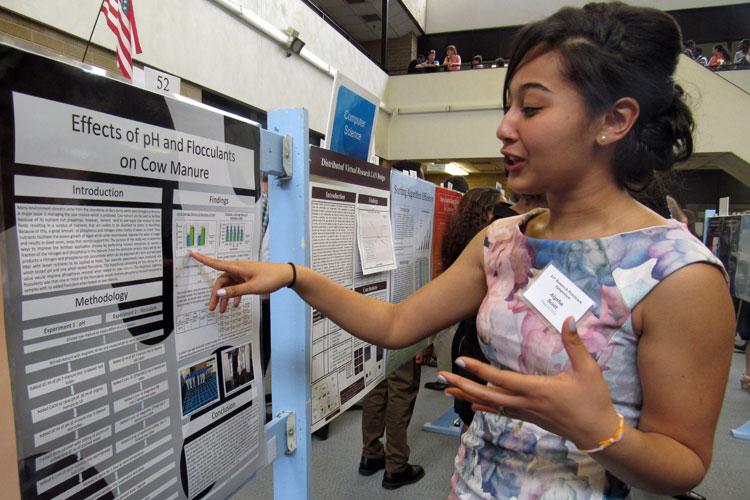Thank you for considering a donation! Your donation will support the student journalists of Eleanor Roosevelt High School - MD. Your contribution will allow us to purchase equipment, produce print editions and cover our annual website hosting costs.
STEM Seniors Celebrate Achievements at Research Practicum Symposium
Research Practicum advisors and mentors, STEM seniors, parents, relatives, and other guests including PG County Executive Rushern L. Baker III packed into the auditorium last Friday for the 31st Annual Research Practicum Symposium.
April 21, 2015
Among the many my-science-is-the-best jokes in Friday’s ceremony at the 31st Annual Research Practicum Symposium, there was a prevailing air of gratitude, happiness, and relief, for students, parents, mentors, teachers, and other guests that gathered to celebrate the completion of Research Practicum, a yearlong science fair project required for seniors in ERHS’s STEM program.
Among the many audience members present, was PG County Executive Rushern L. Baker III, who praised the work of both students and educators at Roosevelt HS. “I wanted to see the fabulous work that the students are doing, and wanted to highlight how important the quality of the education that these kids are getting,” said Baker, on why he came.
The ceremony included, among other things, presentations from selected students about their projects, and many thank yous and acknowledgements.
Hands flew up into the air and cheers abounded as Linda Watson and Susan Peterson received a special thank you for their work helping with RP, including a bouquet of flowers for each. Similarly, seniors shot out of their seats to stand and applaud band teacher Sally Wagner who will soon be retiring, as she received a raider blue necklace as a thank you token.
When Alex Kinder won Science and Tech Teacher of the Year, he spoke to the crowd that ERHS was the best school he’s ever been to, and when Robert W. Newcomb received the Friend of Science and Tech Award, he said that one of his biggest joys was working with high school students.
Over 200 posters hung in the library after the ceremony, with titles ranging from “The Relationship between Self Esteem and Alcohol and Marijuana use in Adolescents,” to “Climate Change and Variability in the Guinea Region of Africa” to “Effect of Parabolic Reflectors on Wi-Fi Signal Strength.” Guests milled about, and could listen to students explain their scientific or mathematical toils of the past school year.
“Somehow every year [the students’ projects and posters] seem to get better and better,” said Jane Hemelt, Coordinator of the Science and Technology Program.
“I look at you guys, and I think ‘I would’ve loved to do this stuff in high school’,” said engineering and RP engineering teacher Arlynda Jorgensen, who felt that not all students are aware of just how beneficial a program like Research Practicum can be, especially for their futures. For current high school students who can relate to Jorgensen’s wish, you might just be in luck, for Baker talked of his hopes for the expansion of such programs.
“When we’re talking about investment in education, Roosevelt is the shining example,” said Baker. “If people know that children can go to this great school right here, they want to move into PG County. Well, we want the example of Roosevelt and the brilliant students here, to be throughout.”
And quite fittingly, one of the reasons for the successful growth of ERHS’s Science and Technology program, according to some, was the advancement of technology itself. With the internet at students’ fingertips and internships at institutions such as the University of Maryland, the US Department of Agriculture and the National Institutes of Health just around the corner, students have the opportunities to branch out into meaningful research that they are interested in, such as with student Matthew Forbes, who worked on the development of a better hearing aid based on the fly species Ormia ochracea, or student Aiysha Scott, who researched “ways to improve the fertilizer application process by extracting nutrients from cow manure and poultry litter,” as stated in her project abstract. Students can also utilize modern technology and available databases to conduct their research, such as with WISP (Watershed Integrated Study Program,) and Forestry.
“I think technology is pushing our students into new areas of research,” said biology and Research Practicum teacher, Jennifer Morgenthaler. “Accessibility to research is completely different than it was 10 years ago.”
“RP itself is so technologically centered,” said senior Pendo Abbo, who presented her project along with fellow student Joshua Kawasaki at the ceremony, which looked into how honeybees are effected by various stress factors.
Jorgensen, like Abbo and Morgenthaler, agreed. “It’s much easier to do the posters than it used to be,” she said, in part due to the use of Powerpoint, a luxury that did not always exist in the 31 years of Research Practicum Symposium. RP Engineering is particularly affected by new technologies, said Jorgensen, for students or any other curious person can teach themselves engineering, such as with the maker movement, a relatively new DIY-like trend. The New Yorker so eclectically described it as, a mix of “3-D-printing enthusiasts who like making their own toys, instruments, and weapons; tinkerers and mechanics who like to customize household objects by outfitting them with sensors and Internet connectivity; and appreciators of craft who prefer to design their own objects and then have them manufactured on demand.”
In the words of Morgenthaler, “We’ve evolved.”

